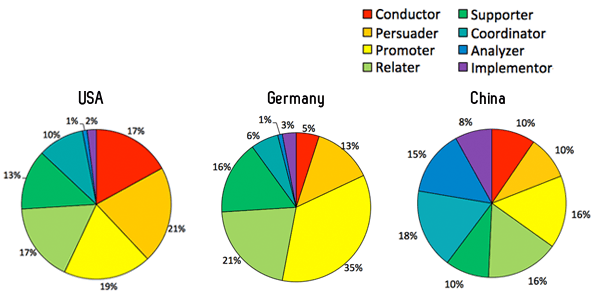5 Mistakes Consultants Make With The DISC Profile
DISC has enjoyed immense popularity and acceptance in the HR/L&D community and among consultants since the late 1980s. With its broad, long-established and passionate fan base, we sometimes find that consultants, coaches and trainers can have a tendency to see people dynamics through the lens of this single tool.
Sometimes this means DISC is used to explain things about people that are beyond the scope of what it is actually designed to measure, while ignoring other important elements of human personality. What follows are 5 of the top mistakes we commonly see consultants make when training or coaching with DISC.
Mistake #1
“DISC is a complete personality profile.”
While DISC is commonly understood as a type of personality test (because it’s often incorrectly marketed this way), DISC is actually a type of behavioural assessment. Understanding this difference is vital, and, in our experience, is almost always ignored or overlooked by inexperienced consultants.
DISC explores four traits within our personality, but the term "personality" is an all encompassing word that goes far beyond the scope of four DISC behavioural traits. Personality is much, much more than our behaviour and includes things like our values, beliefs, sense of humour, character, ethics, temperament, emotional maturity, thinking preferences and manner of communicating.
DISC is not a complete measure of who we are, but simply one aspect of what makes us unique: how we prefer to act and communicate (or behavioural style).
DISC is an extremely valuable tool, but it's not the ONLY tool you need to understand human dynamics. Personality is deeply complex and includes other important elements such as values (see the Motivators assessment) and emotional intelligence (see Emotional Quotient), which should not be ignored when introducing DISC to people for the first time.
Indeed, the ultimate purpose of DISC is to help people improve their EQ, and for this reason the DISC framework should be understood in the context of a broader emotional intelligence framework. For example, imagine the difference between hiring a high I salesperson with high EQ and a high I salesperson with low EQ.
Mistake #2
“All DISC suppliers are offering the same product.”
DISC is not like MBTI, LSI, HBDI or other well-known inventories that are each owned (and trademarked) by a single publishing company. The DISC theory itself (created by William Marston) was never patented, so over the years there have been dozens of different versions developed and sold around the world — each using different questionnaires, levels of accuracy and training methods.
Most of the major sellers of DISC around the world only offer DISC or DISC spin-offs and nothing else that extends beyond measuring behaviour. We believe this approach is limiting. For this reason, we have partnered with TTI Success Insights for more than 20 years to deliver a full suite of assessments.
TTI wrote the industry standard textbook on DISC, were the first to computerise the DISC assessment and have the most highly valid questionnaire on the market. Over and above these things, the most significant point of difference with the TTI suite is that unlike ALL other DISC providers, the TTI suite offers five sciences of human performance: Behaviour, Motivation, Competencies, Acumen and Emotional Intelligence.
This provides consultants, trainers and coaches as well as in-house L&D, HR and OD professionals with better capabilities and a broader scope of solutions.
Mistake #3
“DISC tells you who will be a superstar or dud performer.”
Probably the most common error made in using the DISC model occurs when someone assumes that a DISC profile is going to explain who will succeed or fail in a job. DISC only measures common behavioural tendencies — not skills.
Discovering that someone has a high I style doesn’t automatically mean you should hire them for a sales role. Having a natural preference for interacting with people (high I) does not necessarily mean that the person will be skilled at a complex profession like selling.
DISC does not predict job success — there is no such thing as a "best" profile for an accountant, lawyer, nurse, salesperson, or entrepreneur. Any type of DISC profile can succeed in any type of profession.
It is important to remember that DISC is only one part of the picture and there are many other elements that affect job performance.
The only way to accurately determine whether a person is "well suited" (behaviourally speaking at least) to a job is by objectively and scientifically benchmarking that specific job.
Once a benchmark has been established, DISC can then help the hiring manager flag aspects of the role that might conflict with a candidate’s natural behavioural tendencies. This is the best practice use of the DISC profile in the recruitment process.
Mistake # 4
“You say your boss is pushy, rude and a total jerk face? Well, that’s because of his/her high D.”
It’s possible to have any combination of DISC profile and be thought of as a [insert descriptive adjective]. It's true that high D’s are more likely to rub certain people the wrong way since they have a tendency to be outspoken, candid and won’t shrink from confrontation.
And so the question we get from many leadership consultants and HR professionals becomes something like this: “Is his/her high D the reason the person is a jerk?” The answer is no. If someone is generally thought to be a [descriptive adjective], that would depend on something else, most likely to do with emotional intelligence or underlying core motivators.
To be clear, there is a fine line between being assertive (a common hallmark of the D Style) and being rude (a common hallmark of low EQ). The D may say something candid, that they see as "telling it like it is," but someone else may view the same comment as brutal, and utterly lacking in empathy. In any case, emotional intelligence determines whether you experience the D style as a quick cuddle, or as a tactless sledgehammer.
People who are only trained in DISC will commonly make this mistake, but it is important to keep in mind that emotional intelligence will bring out the best and worst traits in our DISC profile.
Furthermore, if you want to understand the root of conflict then you need to understand values (see the Motivators assessment). Behavioural (DISC) conflict is relatively easy to understand and educate people on, however, people seldom have a framework for discussing their values.
When it comes to business partnerships, just as it does with dating and falling in love, people can overcome basic behavioural differences, but values are the thing that will make or break a relationship.
Mistake # 5
“High D/ I’s are the best salespeople/leaders.”
It’s natural for high I’s to believe they are the best salespeople/leaders. The logic is straightforward enough: high I’s like interacting with people; Sales/leading is all about interacting with people; therefore, high I’s are built for selling/leading.
Many high I's are good at dealing with people — they can be friendly, sociable, warm and enthusiastic — but others aren't. Some high I's can be selfish, shallow, disruptive, unruly, impulsive and noisy. Again, this difference comes down to emotional intelligence — the basis of social effectiveness.
This has been highlighted in a series of research studies conducted around the world comparing behaviours and motivators of top sales performers in different countries.

In the study conducted in the U.S., top sales performers tended to be spread across fourbehavioural patterns (Conductor, Persuader, Promoter, Relater); in the German study, they tended to be spread across three (Persuader, Promoter, Relater). As for China, there is a more even distribution, but the majority of top salespeople in China are Promoter, Relater, Coordinator, Analyzer, with fewer D-blends.
In view of these results, it is reasonable to conclude that salespeople with most behavioural patterns can be top performers, although it is statistically less likely for those with Coordinator, Analyzer, or Implementor in the US and Germany. It is especially less likely for the Analyzer (High C), which only had 1% in both the US and Germany. Whereas in China, having a High C looks as though it is much more beneficial at 15%.
Can we predict top sales performance based on behavioural style or motivators?
The only way it would be possible to work out the most ideal Behaviours and Motivators mix for a specific position would be through a process called Job Benchmarking, Even with a job benchmark in hand, it is still important to remember that behavioural style by itself is not a valid predictor of top sales performance; it only serves as one piece of information to help make a more informed hiring decision.

It is clear, though, that in most benchmarks we could expect to see the Utilitarian value as the highest, and this is a very clear indicator of top sales performance across the three continents in the study. It is reasonable to conclude that if salespeople do not have a Utilitarian value in highest (or second highest) position, they will struggle to succeed. Motivators are actually far more important to know in this situation than DISC.
Learn More
The key theme in this discussion is the need to move beyond just focusing narrowly on someone’s behavioural profile towards building a more complete picture with the use of multiple models.
This is achieved by bringing other sciences into the picture that are designed to complement the DISC assessment but offer more powerful insights through integrated feedback. For more information on how to move beyond DISC, check out the 6-in-1 Accreditation.
Topics:
DISC Profile
Trevor O'Sullivan
General Manager. Since the early 2000s, Trevor has worked with thousands of Talent Management professionals to develop and apply assessment-based talent management solutions for selecting, developing and managing people. Trevor is an active member of the TTI Success Insights (TTISI) Global Advisory Council, contributes to TTISI product development and is a regular presenter at TTISI-R3. He is honoured to have received multiple Blue Diamond Awards and, more recently, the Bill Brooks Impact Award recognising his contributions to the TTISI global network.




0 Comments